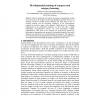Free Online Productivity Tools
i2Speak
i2Symbol
i2OCR
iTex2Img
iWeb2Print
iWeb2Shot
i2Type
iPdf2Split
iPdf2Merge
i2Bopomofo
i2Arabic
i2Style
i2Image
i2PDF
iLatex2Rtf
Sci2ools
91
Voted
ESANN
2003
2003
Developmental pruning of synapses and category learning
After an initial peak, the number of synapses in mammalian cerebral cortex decreases in the formative period and throughout adult life. However, if synapses are taken to reflect circuit complexity, the issue arises of how to reconcile pruning with the increasing complexity of the representations acquired in successive stages of development. Taking these two conflicting requirements as an architectural constraint, we show here that a simple topographic self-organization process can learn increasingly complex representations when some of its synapses are progressively pruned. By addressing the learning-theoretic properties of increasing complexity, the model indicates how pruning may be computationally advantageous. This suggests a novel interpretation of the interplay between biological and acquired patterns of neuronal activation determining topographic organization in the cortex.
Cerebral Cortex Decreases | ESANN 2003 | ESANN 2007 | Simple Topographic Self-organization | Synapses |
| Added | 31 Oct 2010 |
| Updated | 31 Oct 2010 |
| Type | Conference |
| Year | 2003 |
| Where | ESANN |
| Authors | Roberto Viviani, Manfred Spitzer |
Comments (0)

